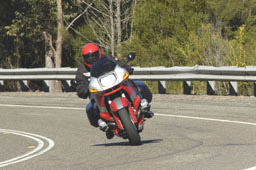Here are some riding exercises you can do almost anywhere.
These allow you to test for yourself your own skill in cornering and discover for yourself, some essentials.
If you don’t understand this, sign up for a professional advanced rider training course.

Approach a curve at a sensible, controlled speed.
You must be able to complete the curve without braking IN the curve.
i.e. have all your braking done well BEFORE you tip in.
Throttle is to be kept just “on” all through the curve, no big handfuls, just steady, don’t shut it, but be ready to open it more as you exit.
Your Homework:-
Ask another rider to ride with you and watch you do this. The observer may help point where you strayed from the wheel track, so you can self-correct. With a group of friends, this is an excellent non-competitive way to build steering control skill.
This can be done in one lane on a multi-lane carriageway, just as it can on a single lane road. In each case, the lane is about 3 meters wide.
WHAT can I learn from this?
WHAT if you can’t do this?
Then learn HOW. You are probably a danger to yourself, your pillion or a rider coming the opposite direction.
WHY do this “tracking”?
Many modern bikes have really good steering and suspension set-ups. So good, they do a lot of the “work” for the rider and the rider may not be fully aware of this.
Specifically, they are “look-there-go-there” setups, so wherever the rider sights, the bike follows.

In a greater than 90 degree curve, from the tip-in point, the rider will sight across the apex of the corner and the bike will follow this sightline, crossing the center line, or at least leaving the tyres on the correct side and having the bike and rider leaning across the centreline. The riders body will then be blocking up to one-third of the lane carrying on-coming traffic around the curve
i.e. the skill to learn is countersteering.
So, how did it go?
What will you look like on camera up the Old road or on Macquarie Pass or on the Alpine way?
Camera shots on here – are set-ups. They are just examples of how to and how not to.
Thanks to Detour Photos (http://www.detourphotos.com/crossroads.html)
Contact Info
The Motorcycle Council of NSW Inc.
PO Box 517
Parramatta 2124
Ph: 1300 679 622 (1300 NSW MCC)
General Enquiries
Please direct enquiries to:
MCCNSW Email
enquiries@mccofnsw.org.au
Site Menu